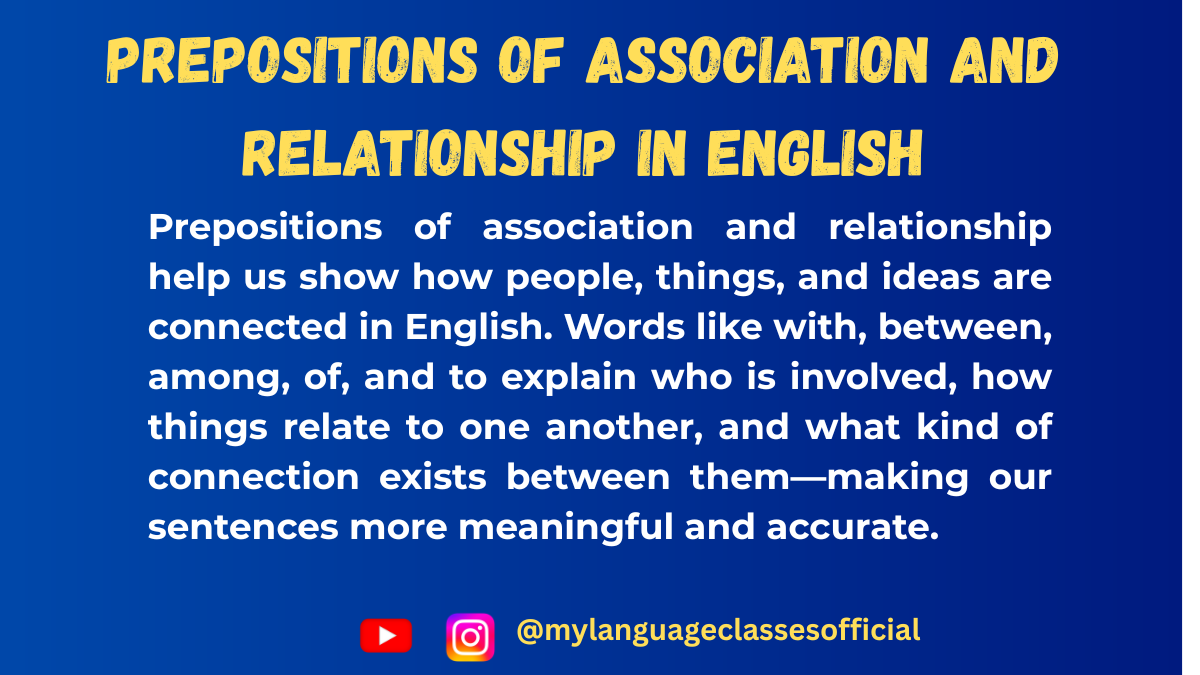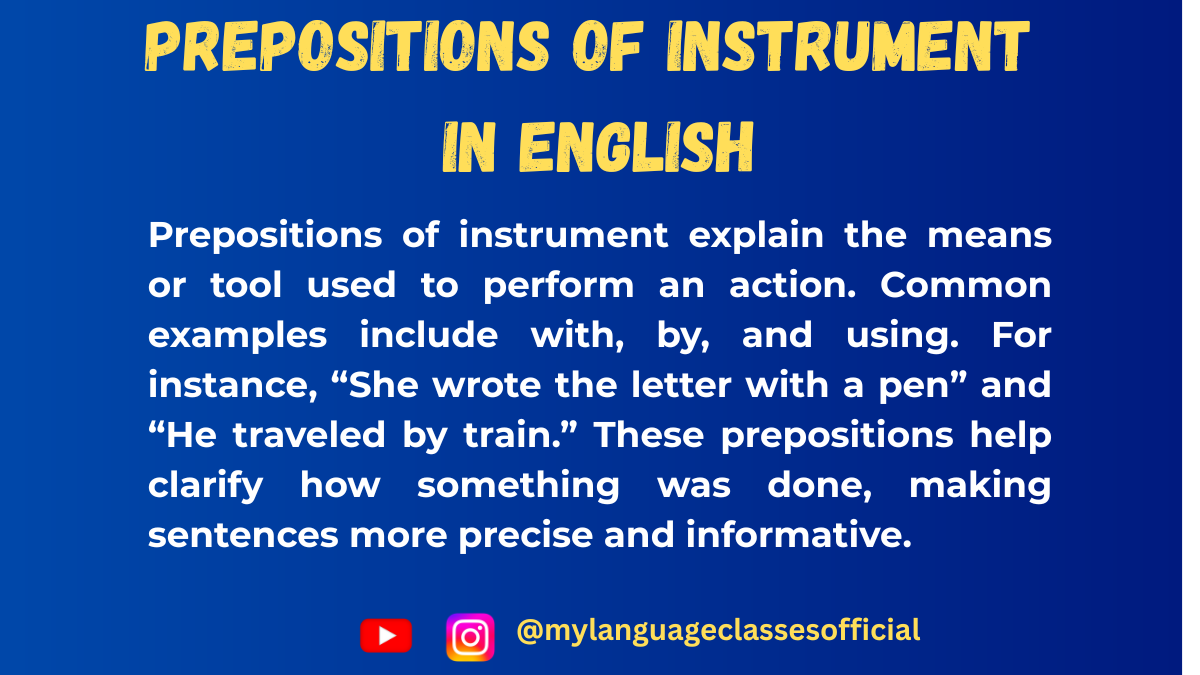Your cart is currently empty!
Tag: types of prepositions
-

Preposition of Association and Relationship in English
Prepositions are small but mighty words that play a crucial role in connecting ideas and providing context in sentences. Among the various types of prepositions, Prepositions of Association and Relationship are particularly important because they help us describe how people, things, or ideas are connected. In this blog post, we’ll explore the usage of these prepositions in detail, provide examples, and offer practical exercises to help you master them.
What Are Prepositions of Association and Relationship?
Prepositions of Association and Relationship are used to indicate a connection or relationship between two or more entities. These prepositions help clarify how people, objects, or concepts are linked, whether through partnership, belonging, or interaction.
Usage of Prepositions of Association and Relationship
These prepositions are used in various contexts, including:
- Partnerships and Collaborations: To describe working or being together.
- Example: She works with a team of experts.
- Ownership or Belonging: To show possession or association.
- Example: This is the book of my friend.
- Relationships Between People: To describe familial, romantic, or social connections.
- Example: He is married to Sarah.
- Connections Between Objects or Ideas: To explain how things are related.
- Example: The key to success is hard work.
- Membership or Inclusion: To indicate being part of a group.
- Example: She is a member of the club.
- Origin or Source: To show where something or someone comes from.
- Example: This gift is from my grandmother.
List of Prepositions of Association and Relationship
Here’s a table of common prepositions of association and relationship, along with example sentences:
Preposition Example Sentences With 1. She went to the party with her friends.
2. He is collaborating with a renowned scientist.Of 1. The color of the sky is blue.
2. This is a picture of my family.To 1. She is married to a doctor.
2. The answer to the question is simple.From 1. This letter is from my teacher.
2. He hails from a small village.For 1. This gift is for you.
2. She has a deep love for animals.About 1. They were talking about the project.
2. This book is about ancient history.Among 1. The secret was shared among friends.
2. She was among the top performers.Between 1. The agreement between the two companies was signed.
2. The conversation between them was intense.By 1. The book was written by a famous author.
2. The painting was created by an artist.Against 1. She leaned against the wall.
2. The decision was against his wishes.
More Example Sentences
- She is always with her best friend.
- The sound of the waves is soothing.
- He is loyal to his team.
- This recipe is from my grandmother.
- I bought a gift for my sister.
- They were arguing about the rules.
- The prize was divided among the winners.
- There is a strong bond between the twins.
- The song was composed by a talented musician.
- The protest was against the new policy.
Fill in the Blanks
Test your understanding by filling in the blanks with the correct preposition of association and relationship:
- She is traveling ___ her colleagues.
- This is a photo ___ my childhood.
- He is always kind ___ animals.
- The letter was ___ the manager.
- The discussion was ___ the new project.
- The cake was shared ___ the children.
- The agreement ___ the two parties was finalized.
- The novel was written ___ a famous author.
- She stood ___ the door, waiting for him.
- The decision was ___ his will.
Answers to Fill in the Blanks
- with
- of
- to
- from
- about
- among
- between
- by
- against
- against
Things to Keep in Mind
- Articles and Gender: Prepositions of association and relationship are not affected by gender or articles. They remain the same regardless of whether the noun is masculine, feminine, singular, or plural.
- Example: with the boy, with the girl, with the books.
- Context Matters: The choice of preposition depends on the context of the sentence. For example, with is used for companionship, while of is used for possession.
- Avoid Overusing Prepositions: While prepositions are essential, overusing them can make sentences clunky. Ensure each preposition adds value to the sentence.
- Practice Regularly: The more you practice, the more natural using these prepositions will become.
Conclusion
Prepositions of Association and Relationship are indispensable tools for expressing connections and relationships in English. By understanding their usage and practicing regularly, you can enhance your communication skills and write or speak more effectively. Remember to pay attention to context and keep practicing with examples and exercises.
If you enjoyed this lesson, be sure to check out more posts like this on my blog at My Language Classes. Don’t forget to subscribe my YouTube channel and follow me on Instagram for the latest language learning tips and lessons. Leave a comment below to share your thoughts, or ask any questions you have about nouns.
Happy learning! 😊
- Partnerships and Collaborations: To describe working or being together.
-

Prepositions of Instrument in English
Prepositions of instrument are used to indicate the means or tools used to perform an action. These prepositions show how something happens or is achieved. They are crucial in English grammar, as they help provide clarity in sentences.
Usage of Prepositions of Instrument
Prepositions of instrument are used in various situations, such as:
- With Tools or Instruments – Used when referring to a tool or instrument that helps complete an action.
- With Modes of Transport – Used when talking about how someone travels.
- With Means of Communication – Used when referring to ways of sending or receiving information.
- With Body Parts – Used when describing actions performed using body parts.
- With Natural Forces – Used when mentioning how something is affected by nature.
- With Materials or Substances – Used to describe the material used to create something.
- With Assistance – Used when referring to a person or thing that helps achieve something.
- With Measurement and Currency – Used when expressing amounts or ways of measuring.
List of Prepositions of Instrument
Preposition Example Sentence 1 Example Sentence 2 by She wrote the letter by hand. He traveled by car. with He cut the paper with scissors. She painted the wall with a brush. through They communicated through email. The water flows through the pipe. using He solved the problem using a calculator. She opened the door using a key. by means of The data was transferred by means of a USB drive. He escaped by means of a secret tunnel. via The message was sent via email. We traveled via London. on She swore on her mother’s life. He played a song on the piano. in The message was written in ink. She expressed her feelings in words. through the use of The document was signed through the use of an electronic pen. The problem was solved through the use of technology. by way of They reached the village by way of the river. He sent the package by way of courier.
More Example Sentences
- She cut the vegetables with a sharp knife.
- He sent me a message via WhatsApp.
- The report was written in pencil.
- We traveled to the city by train.
- He operates the machine using a remote control.
- She delivered the speech through a microphone.
- The bridge collapsed by means of an explosion.
- The poem was written on a piece of parchment.
- The artist sketched the portrait with charcoal.
- They recorded the lecture through the use of a digital recorder.
Fill in the Blanks
- He fixed the broken chair ___ a hammer.
- She traveled to Paris ___ plane.
- The students communicated ___ email.
- He ate the soup ___ a spoon.
- The announcement was made ___ a loudspeaker.
- The letter was written ___ a ballpoint pen.
- They cut the paper ___ scissors.
- The transaction was completed ___ an online payment system.
- The thief entered the house ___ a secret passage.
- The message was transmitted ___ radio waves.
Answers
- with
- by
- through
- with
- through
- in
- with
- using
- by means of
- via
Things to Keep in Mind
- Prepositions of instrument often indicate the method, means, or tools used to perform an action.
- Some prepositions, like by and with, are commonly interchangeable but depend on context.
- The choice of preposition can sometimes depend on the verb in the sentence.
- Articles (a, an, the) may be required before the instrument (e.g., “with a knife”).
- Gender does not play a role in English prepositions, unlike some other languages.
Conclusion
Prepositions of instrument are essential in English to convey how actions are performed. Understanding their correct usage will help improve clarity and precision in communication. By mastering these prepositions, learners can express themselves more effectively in various situations, whether discussing tools, travel, communication, or assistance.
If you enjoyed this lesson, be sure to check out more posts like this on my blog at My Language Classes. Don’t forget to subscribe my YouTube channel and follow me on Instagram for the latest language learning tips and lessons. Leave a comment below to share your thoughts, or ask any questions you have about nouns.
Happy learning! 😊

